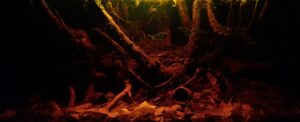Peat swamp nearby Su-ngai Kolok, town in the Thai-Malaysian border
_st place in Biotope Aquarium Design Contest 2022

Volume of aquarium: 110 liters
Dimensions of aquarium: 80x35x40cm
List of fishes: Sphaerichthys osphromenoides, Trichopsis vittata, Boraras urophthalmoides
List of plants: Cryptocoryne sp., Pistia stratiotes, Lemna sp.
Description of Decorations and Substrate: Trunk tree driftwood to simulate the roots and branches of a dead riparian bush. The substrate is peat, mostly covered in a layer of leaf litter.
Description of Equipment: External filter, JBL e902. The lighting used here is the led light included with the tank an an additional 15w LED floodlight.
Water Parameters: Temperature is 25C, the pH is around 4.2. Hardness is 0, TDS 30ppm and conductivity is 47 microsiemens.
Additional Info: The tank is filled purely with RO water. The peat substrate keeps the pH stable. Small water changes of up to 20% are done every now and then. Those are enough to keep bad hormones out of the water while being small and scarce enough to keep the stability.
Aquarium video:
https://www.dropbox.com/s/0c0ilmckixsn514/20220131_224111.mp4?dl=0
Description of the Area Surrounding the Biotope: Su-ngai Golok is a town in the Thai part of the Thai-Malaysian border. Near it are several peat swamps, both in Malaysian and Thai territory. Those peat swamps are surrounded by many large trees which create a thick canopy that doesn’t allow much light to reach the ground. The soil in those areas doesn’t drain water very well and given the area’s humid climate, it leads to waterlogged soils. This causes plant matter to decompose very slowly, forming peat and therefore creating peat swamps.
Description of the Underwater Landscape of the Biotope: The trees and bushes surrounding the biotope drop their leaves into the water. These leaves decompose very slowly, forming a layer of peat that is always covered in some sort of leaf litter. During that process, they leech a lot of tannins, which gives the water the dark brown look. Due to the small volume of these puddles and high amount of biological waste, the water is much darker than the water found in rivers or large lakes. Nearly no aquatic plants are found in the biotope, only riparian plants like Cryptocoryne spp. and on occasion, some floating plants.
Description of the Habitat Parameters: Water is extremely dark, pH tends to be between 3.5 and 4.5. The conductivity can be as low as 6 microsiemens. The temperature varies between 24 and 28C.
List of Fishes and Invertebrates Occurring in the Nature Biotope: Trichopsis vittata, Sphaerichthys osphromenoides, Boraras urophthalmoides, Luciocephalus pulcher, Parosphromenus spp.
List of Plants Found in the Nature Biotope: Cryptocoryne spp., Salvinia spp., Lemna spp., Pistia sp.
Threats to the Ecology of the Biotope: Peat swamps are endangered habitats all over South-East Asia, although in Malaysia the problems seem to be larger. It is believed that around 75% of the peat swamps in Malaysia have been disturbed or even completely destroyed. This is mostly because Malaysia has very good conditions for growing oil palms. Therefore, many forests are cut down in order to make palm oil plantations. Mining and logging and the pollution caused by them also play a part, although to a smaller scale.
Only 4.5% of the peat swamps are currently protected by the government, which means we will sadly see a huge loss of biodiversity in the following years.
Sources of Information:
www.gbif.org
http://www.displa.org/
https://academic.oup.com/bioscience/article-pdf/61/1/49/19404600/61-1-49.pdf
